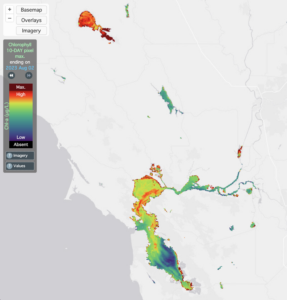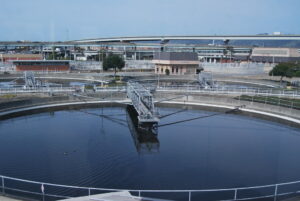Q: Rumor has it there might have been a waterfall at the Golden Gate during the last ice age, when sea level was at its lowest. Is there any evidence for this? [Cisco, Oakland]
A: Well, there is no incontrovertible evidence for a “waterfall” at the Golden Gate, but there very well could have been one in the past. The earth has undergone a number of ice ages over the last 2.5 million years, when the cooler, wetter climate caused the formation of large sheets of ice in the polar regions and at higher elevation, followed by the melting of this ice. This oscillation has caused sea level to periodically rise and fall by as much as 200 to 400 feet over periods of several thousand years.
Some 20,000 years ago, the San Francisco Bay was not a bay, but a broad valley with a river, which we now call the Sacramento, draining the Central Valley through the Carquinez Strait and heading out to the Pacific through the “Golden Gate.” Except it didn’t meet the ocean at the Golden Gate, as it does now. Instead, it ran for another 27 miles across a broad plain past a series of hills (now the Farallon Islands) before draining into the Pacific. In fact, the now-flooded San Francisco Bay is the exception; for most of its life, the “Bay” has been a river valley.
The deepest part of the Bay, at 350 feet or more, is just west of the Golden Gate Bridge. To the east, bedrock at Racoon Strait (sic) between Angel Island and Tiburon is only 140 feet deep. So in just over two miles, the ancient river dropped more than 200 vertical feet. This most likely would have created a series of cascades, if not a waterfall. And right under the bridge is an extraordinarily deep hole in the ancient river channel (download a colorful 3-D map of the Bay floor at bit.ly/BayFloorMap). The existence of the hole is a bit of a conundrum to geologists, some of whom suspect that a good-size waterfall may have created this large cavity in the bedrock. The sheer volume of water passing through this narrow cut in the Coast Range must have been immense. Today, runoff from nearly 40 percent of California’s land area drains out through the San Francisco Bay. During ice ages, there would have been even more water in the river to carve out the canyon. Waterfall or no, these rushing waters would have been an impressive sight, and sound.
As sea level rose at the end of the last ice age about 8,000 years ago, seawater invaded this river valley, creating the modern San Francisco Bay. Evidence of the old riverbed can be seen during winter storms when large waves break over the Potato Patch, a four-fathom shoal made up of sand carried by the ancient Sacramento River on its way out to the Pacific some 30 miles to the west.
Email your questions to atn@baynature.org.




